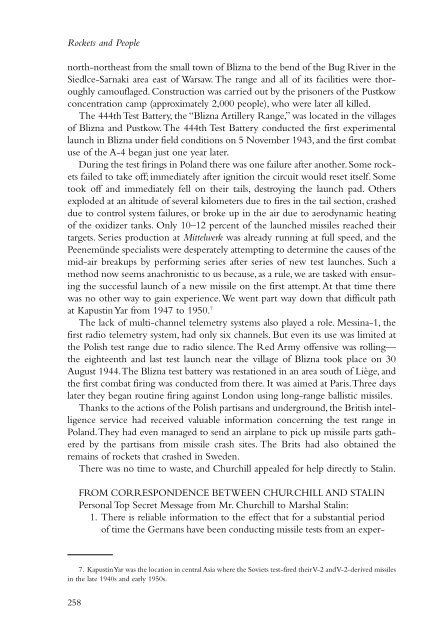to open next chapter. - NASA's History Office
to open next chapter. - NASA's History Office
to open next chapter. - NASA's History Office
You also want an ePaper? Increase the reach of your titles
YUMPU automatically turns print PDFs into web optimized ePapers that Google loves.
Rockets and People<br />
north-northeast from the small <strong>to</strong>wn of Blizna <strong>to</strong> the bend of the Bug River in the<br />
Siedlce-Sarnaki area east of Warsaw. The range and all of its facilities were thoroughly<br />
camouflaged. Construction was carried out by the prisoners of the Pustkow<br />
concentration camp (approximately 2,000 people), who were later all killed.<br />
The 444th Test Battery, the “Blizna Artillery Range,” was located in the villages<br />
of Blizna and Pustkow. The 444th Test Battery conducted the first experimental<br />
launch in Blizna under field conditions on 5 November 1943, and the first combat<br />
use of the A-4 began just one year later.<br />
During the test firings in Poland there was one failure after another. Some rockets<br />
failed <strong>to</strong> take off; immediately after ignition the circuit would reset itself. Some<br />
<strong>to</strong>ok off and immediately fell on their tails, destroying the launch pad. Others<br />
exploded at an altitude of several kilometers due <strong>to</strong> fires in the tail section, crashed<br />
due <strong>to</strong> control system failures, or broke up in the air due <strong>to</strong> aerodynamic heating<br />
of the oxidizer tanks. Only 10–12 percent of the launched missiles reached their<br />
targets. Series production at Mittelwerk was already running at full speed, and the<br />
Peenemünde specialists were desperately attempting <strong>to</strong> determine the causes of the<br />
mid-air breakups by performing series after series of new test launches. Such a<br />
method now seems anachronistic <strong>to</strong> us because, as a rule, we are tasked with ensuring<br />
the successful launch of a new missile on the first attempt. At that time there<br />
was no other way <strong>to</strong> gain experience.We went part way down that difficult path<br />
at Kapustin Yar from 1947 <strong>to</strong> 1950. 7<br />
The lack of multi-channel telemetry systems also played a role. Messina-1, the<br />
first radio telemetry system, had only six channels. But even its use was limited at<br />
the Polish test range due <strong>to</strong> radio silence.The Red Army offensive was rolling—<br />
the eighteenth and last test launch near the village of Blizna <strong>to</strong>ok place on 30<br />
August 1944.The Blizna test battery was restationed in an area south of Liège, and<br />
the first combat firing was conducted from there. It was aimed at Paris.Three days<br />
later they began routine firing against London using long-range ballistic missiles.<br />
Thanks <strong>to</strong> the actions of the Polish partisans and underground, the British intelligence<br />
service had received valuable information concerning the test range in<br />
Poland.They had even managed <strong>to</strong> send an airplane <strong>to</strong> pick up missile parts gathered<br />
by the partisans from missile crash sites. The Brits had also obtained the<br />
remains of rockets that crashed in Sweden.<br />
There was no time <strong>to</strong> waste, and Churchill appealed for help directly <strong>to</strong> Stalin.<br />
258<br />
FROM CORRESPONDENCE BETWEEN CHURCHILL AND STALIN<br />
Personal Top Secret Message from Mr. Churchill <strong>to</strong> Marshal Stalin:<br />
1. There is reliable information <strong>to</strong> the effect that for a substantial period<br />
of time the Germans have been conducting missile tests from an exper-<br />
7. Kapustin Yar was the location in central Asia where the Soviets test-fired their V-2 and V-2-derived missiles<br />
in the late 1940s and early 1950s.
















